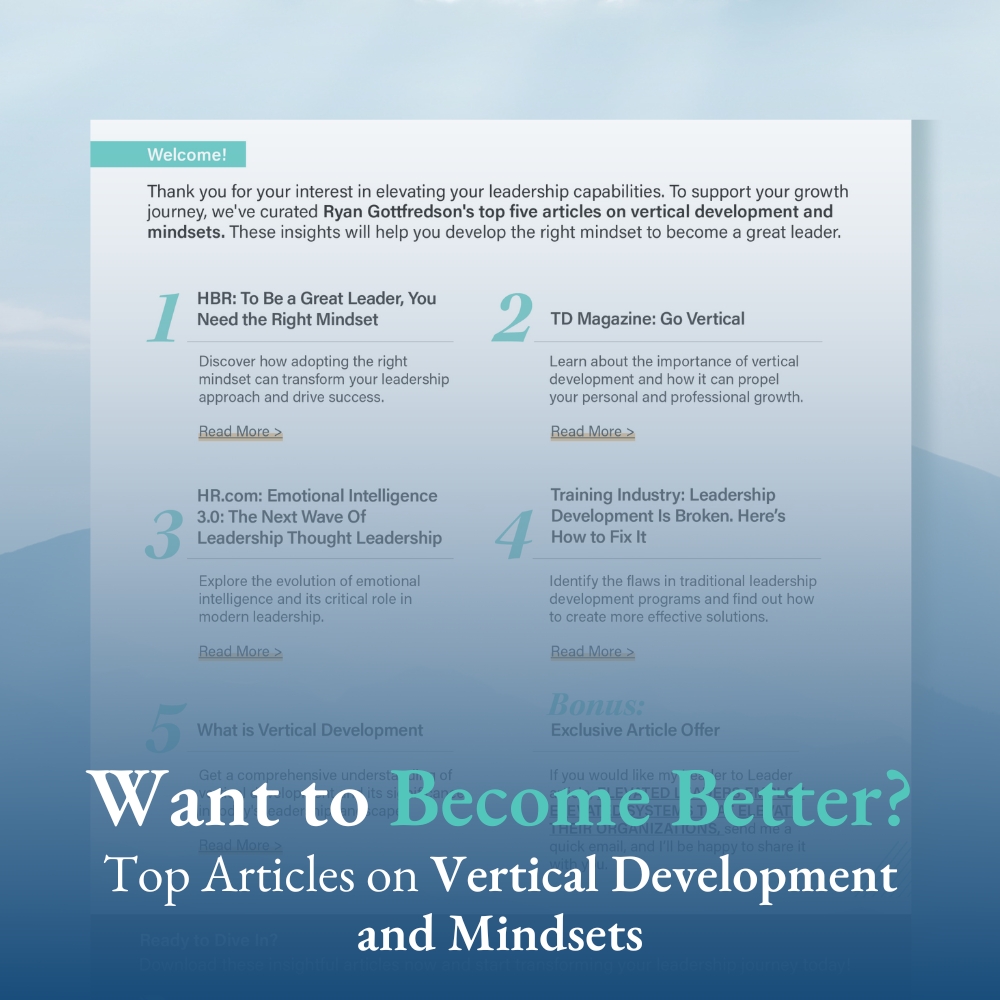(This blog post was inspired by a conversation with my good friend, Lisa Anna Palmer, who is a fantastic consultant and author who is on a mission to bring greater heart into the workplace. Her book is called “Light a Fire in Their Hearts: The Truth About Leadership”).
To understand this article, you need to understand that:
- Vertical development is about enhancing our cognitive and emotional sophistication.
- Developmental psychologists have identified three different vertical development levels that adults can operate from (I call them Mind 1.0, Mind 2.0, & Mind 3.0).
- Adults at the different vertical development levels are internally wired to operate differently. In other words, they have different internal operating systems.
- 64% of adults function with a Mind 1.0 operating system, 35% of adults function with a Mind 2.0 operating system, and only 1% of adults function with a Mind 3.0 operating system.
Knowing that the most vertically developed people, those in Mind 3.0, are “wired” differently and are rare, I commonly get asked the following questions:
- What sets apart or distinguishes Mind 3.0 people from the rest?
- And, is that something that I can develop or replicate?
There are many ways, that we can distinguish Mind 3.0 people from the rest. But, in this post, I want to focus on one particular way Mind 3.0 people are unique, and it is a characteristic that is almost all-encompassing.
A Central Characteristic of those Who Operate at a Mind 3.0 Level
Stated simply, the people that are most vertically developed have the ability and deep-seated interest in creating space.
I think you’ll see what I mean as I walk through five different ways that the most vertically developed seek to create space.
1. Those in Mind 3.0 Create Space for Learning
I have been working on developing a vertical development assessment to help people awaken to what mind level that they predominantly operate from. In the process, I came up with over 50 questions and hired an independent research firm to help me collect data from the general population. I wanted to identify which of these 50 questions best distinguish those who aren’t vertically developed from those who are vertically developed. I found a few things that were interesting.

One of the questions that I asked was: “What best represents your relationship with learning?” And they had 7 options for responding, including the results:
- I don’t invest much in continual learning – 4%
- Combination of 1 & 3 – 5%
- I will invest in my learning if it will help me get ahead – 15%
- Combination of 3 & 5 – 18%
- I am continually seeking to learn – 42%
- Combination of 1 & 5 – 8%
- Combination of 1, 3, & 5 – 8%
Looking at options 4 & 5, it appears that 60% of people state that they are continually seeking to learn.
But, in another question, I asked: “How often are you reading books or articles or listening to podcasts for your growth and development?” Here are the results:
- Rarely – 28%
- Combination of 1 & 3 – 10%
- Occasionally – 22%
- Combination of 3 & 5 – 13%
- All the time – 18%
- Combination of 1 & 5 – 4%
- Combination of 1, 3, & 5 – 5%
This indicates that only 18% are continually seeking to learn (at least through books, articles, or podcasts).
I think there is a disconnection between what people tell themselves and what they do when it comes to our learning and development.
And, what sets Mind 3.0 people apart is that they actually are continually invested in their learning and development. They don’t just talk the walk, they walk the talk.
2. Those in Mind 3.0 Create Space for Honest Self-Awareness
I found some additional interesting findings from my data collection items here.
First, I commonly ask people in my workshops the question, “How do most people respond to constructive criticism?” In response to this, at least 75% of people respond to this question by saying some form of “poorly” or “defensively.”
So, I was rather shocked with the results that I got from the question, “How do you typically make meaning of constructive criticism?”
- This is an attack – 2%
- Combination of 1 & 3 – 3%
- This might be an attack – 9%
- Combination of 3 & 5 – 23%
- This is an opportunity to learn and grow – 41%
- Combination of 1 & 5 – 12%
- Combination of 1, 3, & 5 – 10%
What this implies is that most people are unwilling to either see or indicate that they commonly get defensive when they receive constructive criticism.

Another question that I asked was: “When someone contradicts a strongly held belief of yours, how do you typically react?” Here were the results:
- I avoid them – 11%
- Combination of 1 & 3 – 11%
- I get defensive – 6%
- Combination of 3 & 5 – 15%
- I seek to understand where they are coming from – 37%
- Combination of 1 & 5 – 12%
- Combination of 1, 3, & 5 – 9%
I would say that I was a little shocked that only 28% of people said that they avoid the people that contradict their strongly held belief or get defensive.
These are just a couple of ways that, to me, indicate our willingness to thing more highly of ourselves than how we likely operate.
To me, what these findings reveal is that those in Mind 1.0 and Mind 2.0 have a difficult time creating space for honest self-awareness. They don’t like to create space for investigating the aspects of themselves that may not be the most pleasing.
But, those in Mind 3.0 know that the more willing they are to investigate the unpleasing aspects of themselves, the more quickly they grow, learn, and develop.
3. Those in Mind 3.0 Create Space to Connect with Their Bodies
I do a lot of coaching calls with people, and in these calls, I walk people through a vertical development exercise. As a part of this exercise, I help the person identify fears that they carry around that are causing them to self-sabotage themselves.
What is interesting to me is that people vary in their ability to connect with their fears. Some people get there before I do, while other people will say things like: “I don’t have any fears” or “I am not driven by fear!”

What I have learned is that those who are the most vertically developed have an enhanced capacity to connect with the deep-seated feelings in their body, which includes their fears.
For more on this, read this post: Trauma & Leadership – Part 2 – What are the Primary Consequences of Trauma?
4. Those in Mind 3.0 Create Space for Responding (as opposed to Reacting)
When people aren’t very vertically developed, their brain isn’t as mature as it could be, and what commonly happens is that their reptilian and mammalian brains operate on overdrive (think amygdala hijack), and their human brain (home of conscious thought) has a difficult time stepping in and slowing down and regulating the reptilian and mammalian brains. When this happens, people react to their situations as opposed to intentionally responding.
Those who are the most vertically developed, they develop the capacity to create space between a disconcerting episode and response.
For example, if a referee in a game makes a bad call, do you immediately react? Or, do you create space for a thoughtful response?
For more on this, read this post: Trauma & Leadership – Part 2 – What are the Primary Consequences of Trauma?
5. Those in Mind 3.0 Create Space for Connecting with Others
There are two different ways that those in Mind 3.0 create space for connecting with others.
The first way is on a one-on-one level. Those who are in Mind 3.0 have the willingness and ability to let others into their bubble.
To demonstrate this, let’s consider empathy. In order to have empathy for another, you have to let them into your bubble. You have to create a space for their feelings within you. Those who operate in Mind 3.0 have a greater capacity to do this.

Those who are in Mind 1.0 or Mind 2.0 prefer to keep a safe and protected distance between them and others. So, instead of providing empathy, they are more inclined to provide sympathy.
The second way is on a group level. Those in Mind 3.0 want to create an environment where those in the environment have the space to be themselves or to share their ideas and opinions, even if they may differ from the majority’s ideas and opinions. In short, they are concerned about psychological safety and are conscious and intentional about creating an environment of psychological safety.
Summary
How great are you at creating space?
I wonder if:
- Mind 1.0 people have an internal operating system wired to create a comfortable space for themselves
- Mind 2.0 people have an internal operating system wired to fill the space they are in (think ego)
- Mind 3.0 people have an internal operating system wired to create space within them and outside of them









